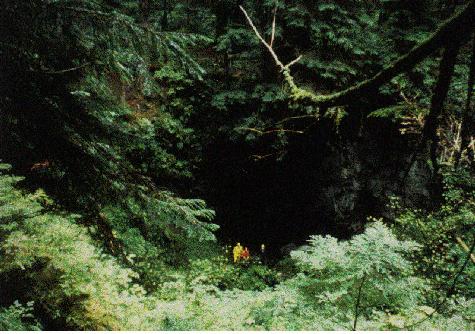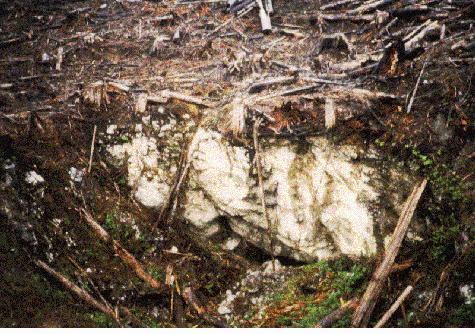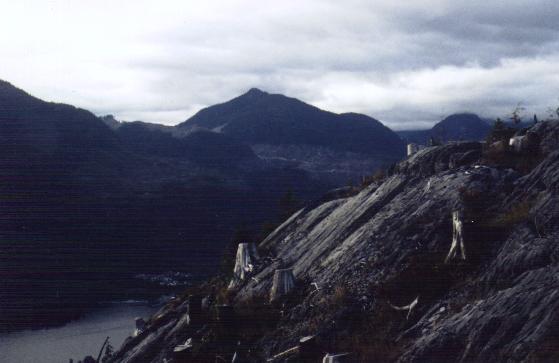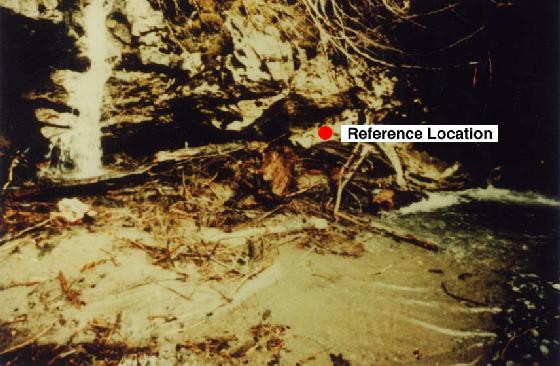Impact of Industrial Forest Operations
Part 2

We started by proclaiming that one of our prime concerns over the past two decades has been the impact of industrial forest operations. It persists as a major problem today, notwithstanding the best efforts of some Ministry of Forests (MOF) recreation officers and industry personnel in the field. There are in fact success stories here and there, but these are not the subject of our presentation. Karst resources are not randomly dispersed on Vancouver Island. They usually occur at hydrogeologically suitable locations such as valley slopes or bottoms.
One obvious consequence of this distribution is a high risk of exposure to timber harvesting. The situation is not new. It emerged as an urgent problem in the mid-seventies when significant karst resources were being hard hit. Though a consensus existed as to the relative significance of sites, one by one the sites were degraded. By the early eighties provincial government cave management policy statements and draft MOF guidelines were introduced to control the impact on caves. These described the procedure for excluding surface areas from timber harvesting and indeed in some cases small "reserves" were established around certain features.
As a result, we saw an increase in management activity. However, the continual expansion of logging road systems and timber harvesting, along with other activities such as slashburning continued to threaten the most valuable examples of the resource. In many instances, development plans were routinely submitted and approved without first classifying the sites and then establishing an appropriate protection zone.
In many instances, development plans were routinely submitted and approved without first classifying the sites and then establishing an appropriate protection zone.
Case Histories
Case histories provide insight into and understanding of the general impact of forest management practices on karst resources. Since 1978, six of Vancouver Island's major known karst systems have been damaged. These are Minigill Cave, Vanishing River, Coral Cave, Hollow Cave, Arch Cave, Paradise Lost, and Glory 'Ole. Several others are in imminent danger of being damaged.
Impacts
Roads and Ballast Quarries
The construction of log hauling roads is a constant threat to caves. Both road building and quarrying are often undertaken without due consideration for the underground phenomena which are known to potentially exist.
Windthrow
Another detrimental impact clearly associated with forest operations is the windthrow which can occur along the windward edge of timber stands exposed by adjacent clearcutting. The inevitable consequences have dramatically altered some of the most significant karst sites. Windthrow destroys old growth forest habitat and dislodges underlying soil and bedrock on a massive scale. The problem of protecting low to medium elevation karst sites from this "premeditated" windthrow should be a prime concern of forest managers. In the past we have advocated the careful design of windfirm cutting boundaries, together with a buffer zone as an added margin of safety. There is so little mature forest left today that this may no longer be an option.
Soil Disturbance

Though the vulnerability of karst has been long established elsewhere in the world, we have in some cases continued to operate as though in the biblical era when ignorance of the problem was a possible excuse. The general problem of soil loss is an example. Soil and bedrock disturbances around the rim and on the interior slopes of steep-walled depression features such as dolines is an important problem.
This photo of slope falure and exsessive debris around Quatsino Resurgence (taken May '96,logged early '60's)
The soil covering undisturbed slopes is already very thin, and the forest vegetation is very difficult to restore. Unfortunately, gravity attracts loose material to the bottom of the depressions, and most cave entrances occur... at the bottom. Away from depressions it would appear that the depth of soil in Vancouver Island karst is measurably changed by clearcutting. As much as a 60% reduction in depth was measured in limestone bedrock where the mean soil depth before cutting was about 25 cm. The reduction on volcanic bedrock of similar pre-harvest soil depth, gradient and aspect was insignificant by comparison.
Recreational Access
Multiple use or integrated forest management is supposed to benefit the range of forest values. Yet there are cases where this management objective has actually diminished the values of caves. There is no better example than the problem of access. We described earlier the problem of access that persisted until about 1974, followed by a period of comparatively liberal access. There are instances, though, where road access has actually declined over recent years.
Ironically, it is quite often more difficult to reach a cave destination after development of an area. This is due in part to the revival of gating, the removal of bridges, poor maintenance, and trench cutting. It is also due to reduced off-road mobility. Logging residue and second growth thinnings are left to rot on the ground, making passage difficult if not dangerous for a period of several years. Logging residue and second growth thinnings are left to rot on the ground, making passage difficult if not dangerous for a period of several years.
Visual Quality
Severe visual degradation of various surface karst features, including scenic cave entrances, has been a major concern of cavers. The impact of clearcutting on natural entrance characteristics is so great that even the most careful of procedures cause adverse visual changes. Where entrance zones have successfully revegetated, the new growth can be very dense and obtrusive. It can completely obscure the midground and background of a former vista for a period of 25 years or more. In some cases the foreground is reduced to as little as 2 m. This visual degradation evokes a strong emotional impact on many members of society. Visitation to sites affected in this manner has noticeably declined. In some cases, such as the Devil's Bath, Northern Vancouver Island ,it has exerted a negative local economic impact.
Where significant karst sites are concerned, perhaps it would have made sense to exclude the feature area from timber harvesting.
Solid Wood Residues

Perhaps the most obvious polluting effect of clearcutting has been the introduction of coarse organic debris such as trunks, slabs, branches, and twigs directly into caves. It would appear that some of the cave entrances have actually been used for disposal of this unwanted residue.
The average amount of residue remaining after clearcutting has declined , but even under the current so-called "zero waste" policy, the volume of small residue such as branches and twigs has remained the same. It is not surprising, therefore, that a considerable amount of smaller debris is available to migrate into cave entrances. The problem is not just one of environmental pollution and aesthetics. The accumulations impede access to cave entrances, and pose a serious hazard to the unprotected visitor. As well, the debris can often smother the smaller vegetation, destroy wildlife habitat, and cover deposits of scientific interest.
In extreme cases, entrances can be completely blocked, thereby closing the interior of the cave to larger animals (including cavers). An example of entrance clogging is illustrated by this river swallet.
As this July 1977 photo shows, the natural entrance admitted the sinking river into a solutionally enlarged conduit. The floor of the passage was made up of cobbles with a small quantity of organic debris. The ceiling height at the drip line is approximately 4 m. At this time, we explored the entrance passage for about 15 m before we were stopped by a ledge and reduced airspace above a raging torrent. This lost river, which is known to contain freshwater fish, resurges about 2 km downstream. The summer base flow of the lower surface watercourse is maintained by the cold emergent water.
This photo taken in February 1984 shows a much different entrance. The swallet is obstructed by fine sediments and fresh tree limbs. A matrix of larger pieces is supporting the finer organic debris. The airspace above the obstruction is about 50 cm high. The debris is thought to have originated with upstream cutting which had started some weeks before. It was suggested that the debris could be a seasonal phenomenon, to be cleared during the high velocity spring or fall run offs. However, the clogging persisted for several years.
Forest Chemicals
Forest chemicals such as pesticides can be used to illustrate the vulnerability of karst aquifers. In normal use pesticides are applied in a manner so as to minimize adverse effects on non-target organisms. For example, direct application to surface waters and buffer strips is avoided. These measures reduce entry and impact of the pesticides in aquatic habitats such as ponds, lakes, and streams. The same margin of safety cannot be assumed when pesticides are applied over or near karst systems, especially from the air. For one thing, karst openings are difficult to see and may be sprayed along with the rest of the area. Contaminated detrital matter from adjoining areas can also migrate into cave systems. Also, pesticides and their residues can rapidly infiltrate directly into the karst aquifer.There are many more examples of impacts - petroleum product spills, formation staining, dessication of entrances, flooding...
Visitor Impact on Caves
Clearly, several characteristics of caves endanger them as a resource. They are virtually non-renewable - a typical cave may be as much one hundred thousand years old. In the case of delicate interior features such as stalactites, they may take thousands of years to form. They certainly would not be replaced in our lifetime if destroyed, and in the case of certain rare speleothems (cave formations) they may never be replaced.
So by now some of you may be thinking - but what of the impact of visitor use? Well, it is true that a visitor will always leave a trace. Several of the Horne Lake Caves, for example, bear the scars of abuse which peaked before the sixties. Where wild caves are concerned, however, even those which are well known to local populations, we have rarely seen willful degradation or vandalism (e.g. breakage, graffiti, litter, etc.).
Some damage is emerging at a handful of sensitive caves which were exposed by clearcutting, against our advice. This has happened recently when the public was incited to visit these caves by location maps, directional signs, and/or access trails . This problem simply underscores the importance of user management in these cases.
Next Section - An Eco-System Approach to Karst Management



